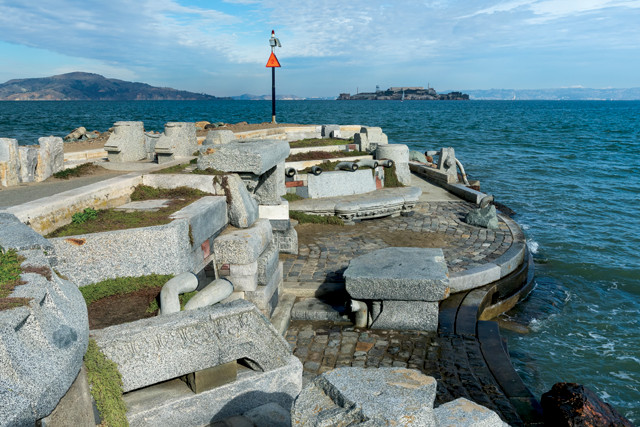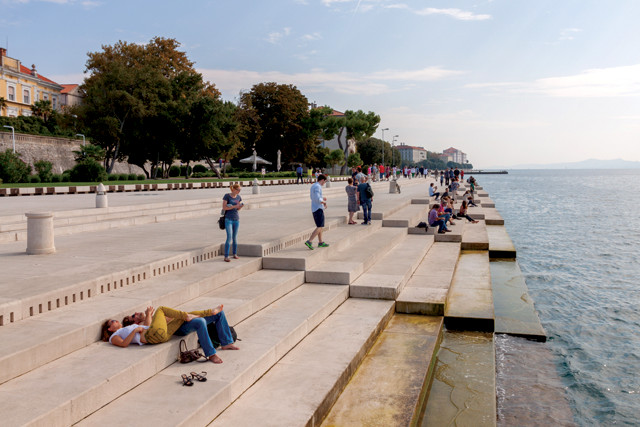
by Bethany Augliere Tuesday, December 27, 2016

The Wave Organ is a collection of pipes on a San Francisco jetty. Credit: Frank Schulenburg, CC BY-SA 4.0.
At the ocean’s edge, the crash of waves against the shore is a familiar sound. It might be rhythmic, but it’s not particularly melodious. There are, however, a few spots around the world where the tides, waves and wind make actual music, thanks to acoustic man-made structures that use the movements of seawater to produce sound. Currently, three of these so-called tidal organs have been built, one each in Croatia, England and the United States.
The first of these instruments, the Wave Organ in San Francisco, was created in 1986 as a collaboration among the Exploratorium science museum, artist Peter Richards and sculptor George Gonzales. The organ pipes are dispersed on a jetty in the San Francisco Bay, with views of the iconic Golden Gate Bridge and Alcatraz Island. The jetty itself was constructed from carved granite and marble recycled from a demolished cemetery, as well as donated curbstones from the city, which were also used to create the organ pipes. But people standing on the jetty might not even notice the organ, says Peter Barto, a California resident and science enthusiast who first visited the site a few years ago and often points visiting friends to the instrument. “It really blends in; it looks like a ruin,” he says.
The organ is a collection of 25 polyvinyl chloride and concrete pipes set vertically and extending into the ocean. As the tide ebbs and flows, water sloshes in and out of the tubes. This action constantly changes the volumes of air in the pipes, producing the melodic sounds that we hear, says Bruce Howe, a physical oceanographer at the University of Hawaii at Manoa. The length and diameter of each pipe play a role in the sound it makes: The shorter the pipe, or the smaller the volume of air, the higher the range of pitches produced; the longer the pipe, or the larger the volume, the lower the pitch range.
The organ is most active at high tide. Lively wave action can create a popping sound in the pipes, similar to a conga drum, Barto says. At other times, he says, the effect is subtler. “It’s not a constant sound. You have to sit there and absorb it.” The eerie, atonal sounds, he says, remind him of those made by the didgeridoo — an Australian wind instrument.

The Morske Orgulje, or Sea Organ, in Zadar, Croatia, is one of the country's top attractions. Credit: Ben Snooks, CC BY-SA 2.0.
The beginnings of what would become the organ date to World War II, when the Allies bombed the 3,000-year-old town of Zadar and destroyed 60 percent of the city’s buildings. When the town was rebuilt, stone from burned buildings was used to create a concrete coastline. In an attempt to increase tourism, the city updated the uninviting and unappealing pier in the early 2000s to accommodate large cruise ships. The architect of this renovation was Nikola Bašić, who took the plans a step further and designed the Sea Organ underneath the concrete. It opened to the public on April 15, 2005. Now, people can walk around the pier and listen to the undulating harmonies as the sea meets the pipes beneath them. The Sea Organ of Croatia won the European Prize for Urban Public Space in 2006. In 2015, TripAdvisor Travelers’ Choice listed it as a top 10 Croatian landmark.
The most conspicuous of the three tidal organs is the High Tide Organ, located in Blackpool, England. It is a mix of concrete and metal that stands 15 meters tall and resembles the neck of a guitar. Eighteen pipes within the sculpture attach to eight buried pipes that extend through a sea wall out to the water.
Sea organs are not the only man-made acoustic instruments that utilize natural features. A pipeless organ sits deep in the caves of Luray Caverns, just outside Shenandoah National Park in Virginia. The Great Stalacpipe Organ was built by Leland Sprinkle, a mathematician and electronics scientist, in 1954. Unlike the sea organs, it is played by a human using a piano-like keyboard, which causes the instrument to strike 37 stalactites with rubber-tipped mallets to produce tones similar to a xylophone or bells. It’s considered the world’s largest musical instrument because the organ’s stalactites span an area of almost 1.5 hectares.
These musical tourist attractions combine nature and art, and offer opportunities, Howe says, for visitors to “pick up a little science along the way.”
© 2008-2021. All rights reserved. Any copying, redistribution or retransmission of any of the contents of this service without the expressed written permission of the American Geosciences Institute is expressly prohibited. Click here for all copyright requests.